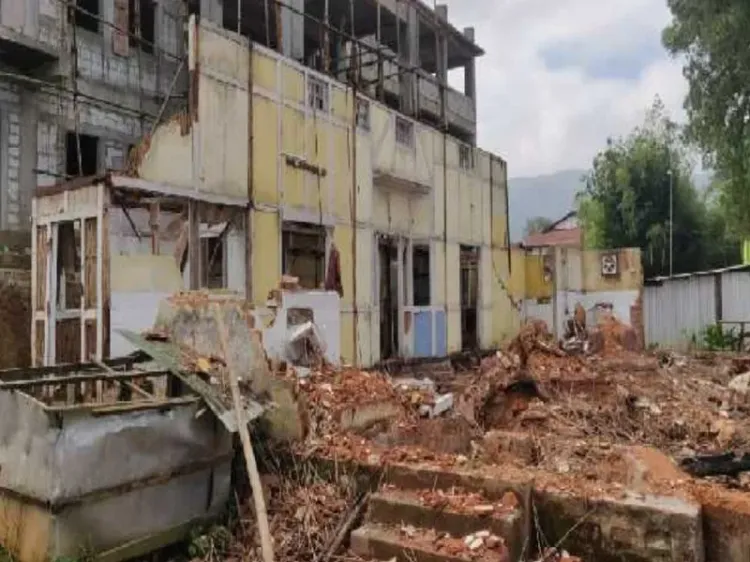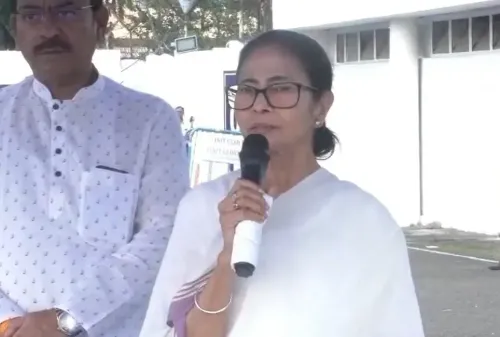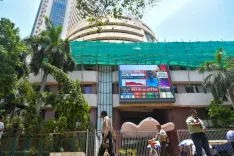Why Are Manipur Student Bodies and CSOs Opposing the Demolition of Shillong's Historic Redlands Building?

Synopsis
Key Takeaways
- Outrage from student bodies and CSOs over the demolition of the Redlands Building.
- Historical significance as the site of the Manipur Merger Agreement.
- Concerns about erasure of heritage and political identity.
- Demands for transparency and accountability from the government.
- Call for preservation of Manipur's cultural legacy.
Imphal, Oct 12 (NationPress) Six leading students' organisations along with numerous Civil Society Organisations (CSOs) have expressed their outrage over the demolition of the iconic Redlands Buildings in Shillong, also known as Manipuri Rajbari. Historians highlight that this building was the site of the controversial Manipur Merger Agreement, which was signed on September 21, 1949, between Maharaja Bodhachandra Singh and representatives of the Union of India. This historic structure, built in the 1940s in the capital of Meghalaya, Shillong, holds significant value.
Following the merger agreement, the once-independent princely state of Manipur officially merged with the Indian Union in October 1949.
The Redlands Building served as the residence for Maharaja Bodhachandra Singh in Shillong. On Sunday, six major student organisations from Manipur vehemently denounced the demolition that occurred last week, labeling it an effort to erase the state's history, identity, and political legacy.
These student bodies, including the Manipur Students’ Federation (MSF), Democratic Students’ Alliance of Manipur (DESAM), and All India Manipuri Students’ (AIMS), warned authorities against actions that jeopardize the heritage and political identity of the former nation.
Hijam Roshan, co-convenor of the alliance of six student bodies, pointed out that the Manipur government’s Planning and Development Authority (PDA) claimed that a proposal for rehabilitation or a replica of the Redlands Building had received approval from the North Eastern Council (NEC) in July 2023.
He questioned the Arts and Culture Department of the state government about their silence on this critical issue, which pertains to national significance and state heritage.
Roshan firmly asserted that the student organisations would not let this matter go unchallenged. He raised concerns about potential hidden motives behind the building's demolition and promised that the organisations would continue to demand accountability.
The student bodies insisted on transparency in decision-making regarding heritage sites and urged the government to respect and safeguard Manipur’s historical and political legacy.
Simultaneously, leaders from various CSOs, including the Peoples’ Organisation Manipur (IPOM), Meitei Pangal Council Manipur (MPCM), Manipur Peoples’ Front, and World Meitei Organisation (WMO), condemned the act as an “insult to the people of Manipur.”
IPOM Vice President, Chandramani Khuman, remarked that the demolition of this historic structure, which is deeply intertwined with Manipur’s political history, without public consultation, indicates a serious disregard for the people's sentiments.
Criticizing the Arts and Culture Department for its lack of transparency, Khuman stated that the department should have informed the public about any developmental activities planned for the historic Redland site in Shillong.
“This iconic building is not merely a structure; it constitutes a vital part of Manipur's history and identity. The destruction of such a crucial edifice without public knowledge or discussion is unacceptable,” Khuman stressed.
Responding to the PDA’s statement regarding the reconstruction of a replica of the Redland Building using salvaged materials, Khuman dismissed the explanation as “unacceptable and casual.”
He noted that such justifications only serve to heighten public outrage rather than addressing their concerns. The PDA is now required to present a clear plan, proposed replica, and timeline for the reconstruction of the new structure.
The CSOs collectively branded the demolition of the Redlands Buildings as a “historical blunder” and demanded accountability from the PDA, the implementing agency, and the Department of Art and Culture.
They called for the government to ensure public involvement and transparency in future decisions regarding heritage structures that are part of Manipur’s political and cultural legacy.
Meanwhile, Meghalaya Chief Minister Conrad K. Sangma, also the President of the National People’s Party (NPP), visited Imphal last week to evaluate the ongoing ethnic crisis in Manipur.
In a media statement, Sangma categorically denied any involvement from his government, asserting that no permissions were granted by the Meghalaya government for the demolition.
Despite repeated requests from heritage groups and former Union Minister of State for External Affairs and Education, Dr. Rajkumar Ranjan Singh, to preserve the site, the building was demolished, reportedly to pave the way for a new Manipur Bhavan.
This decision has sparked widespread condemnation from various organisations, including the Meitei Heritage Society, historians, scholars, and concerned citizens, all of whom view the demolition as an irreparable loss to Manipur’s political and cultural heritage.
Congress’ Lok Sabha Member from Inner Manipur, Angomcha Bimol Akoijam, expressed his deep concern over the demolition of the historic Redlands Building, calling it a direct assault on the dignity and history of Manipur.
“It’s deeply saddening. I feel we are failing to preserve our historical heritage. The Redlands Building is integral to Manipur’s history, even though it lies outside the state,” Akoijam told the media. He further noted that it relates not only to Manipur's history but also to India's history and its evolution into a post-colonial state in 1947, demanding the restoration and reconstruction of the Redlands Building in its original form, urging the government of India to declare and preserve it as a National Heritage site.









